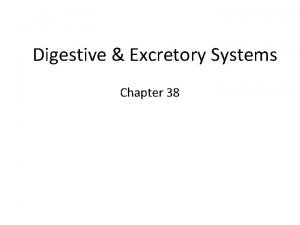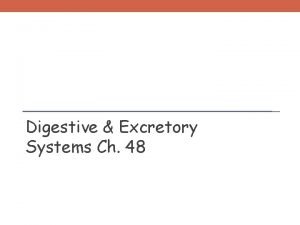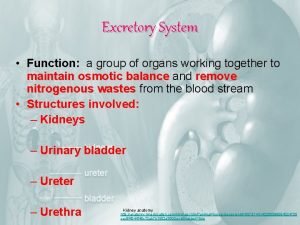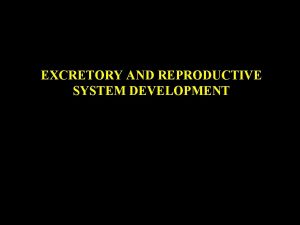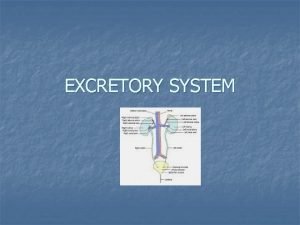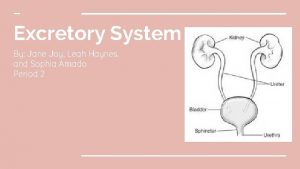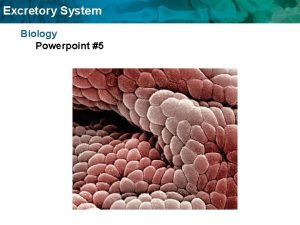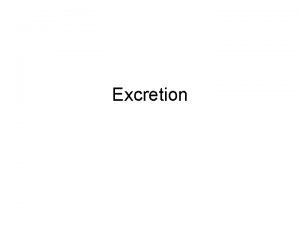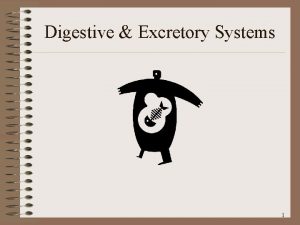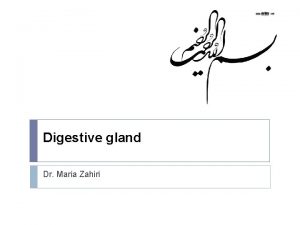Unit 1 Lesson 4 The Digestive and Excretory
















- Slides: 16

Unit 1 Lesson 4 The Digestive and Excretory Systems Copyright © Houghton Mifflin Harcourt Publishing Company

Unit 1 Lesson 4 The Digestive and Excretory Systems You Are What You Eat! What is the digestive system? • Cells use nutrients from food for energy, growth, maintenance, and repair. • The digestive system breaks down food into nutrients that can be used as building materials that provide energy for cells. Copyright © Houghton Mifflin Harcourt Publishing Company

Unit 1 Lesson 4 The Digestive and Excretory Systems What are the two types of digestion? • Mechanical digestion is the breaking, crushing, and mashing of food. • Chemical digestion occurs when large molecules of food are broken down so that they can pass through the bloodstream. • An enzyme is a chemical that breaks down large molecules into smaller molecules. Copyright © Houghton Mifflin Harcourt Publishing Company

Unit 1 Lesson 4 The Digestive and Excretory Systems Chew on This What are the parts of the digestive system? • The mouth is where mechanical and chemical digestion begins. Saliva helps to break down food. • Food moves through the throat into a long tube called the esophagus. • Muscle contractions called peristalsis move the food to the stomach. Copyright © Houghton Mifflin Harcourt Publishing Company

Unit 1 Lesson 4 The Digestive and Excretory Systems What are the parts of the digestive system? • The stomach is a muscular bag that crushes food and contains acids and enzymes for killing bacteria and breaking down proteins. • Chyme is the mushy mix of food that passes from the stomach to the small intestines. Copyright © Houghton Mifflin Harcourt Publishing Company

Unit 1 Lesson 4 The Digestive and Excretory Systems What are the parts of the digestive system? • The small intestine is a muscular tube where most chemical digestion takes place and most nutrients are absorbed. • In the large intestine, water and nutrients are absorbed, leaving waste. Copyright © Houghton Mifflin Harcourt Publishing Company

Unit 1 Lesson 4 The Digestive and Excretory Systems What are the parts of the digestive system? • Identify and describe the parts of the digestive system. Copyright © Houghton Mifflin Harcourt Publishing Company

Unit 1 Lesson 4 The Digestive and Excretory Systems Where are nutrients absorbed? • The pancreas makes fluids that break down proteins, carbohydrates, fats, and nucleic acids. • The liver makes and releases a mixture called bile that is stored in the gall bladder. • Bile breaks up large fat droplets. Copyright © Houghton Mifflin Harcourt Publishing Company

Unit 1 Lesson 4 The Digestive and Excretory Systems Where are nutrients absorbed? • The walls of the small intestine have many folds that increase the surface area, allowing more room for nutrients to be absorbed. • Each fold has villi, which are covered with microvilli, that absorb more nutrients. Copyright © Houghton Mifflin Harcourt Publishing Company

Unit 1 Lesson 4 The Digestive and Excretory Systems Where are nutrients absorbed? • The large intestine removes water, absorbs vitamins, and turns food into waste called feces. • Bacteria live in the large intestine to help break down foods the body cannot use or digest. • The rectum is the end of the large intestine that stores feces until they can be expelled by the anus. Copyright © Houghton Mifflin Harcourt Publishing Company

Unit 1 Lesson 4 The Digestive and Excretory Systems Toxic Waste! What are the functions of the excretory system? • Waste in the body would become toxic without a method to eliminate it. • The excretory system eliminates cellular wastes from the body through the lungs, skin, kidneys, and digestive system. Copyright © Houghton Mifflin Harcourt Publishing Company

Unit 1 Lesson 4 The Digestive and Excretory Systems What are the functions of the excretory system? • Excess salts are released through the skin as you sweat. • The lungs release carbon dioxide and water as you exhale. • The kidneys and the digestive system remove cellular waste. Copyright © Houghton Mifflin Harcourt Publishing Company

Unit 1 Lesson 4 The Digestive and Excretory Systems Cleanup Crew What organs are in the urinary system? • A kidney is one of a pair of organs that remove waste from the blood. • Nephrons are structures in the kidneys where fluid is filtered from the blood. • Water and wastes filtered from the blood form a liquid called urine. Copyright © Houghton Mifflin Harcourt Publishing Company

Unit 1 Lesson 4 The Digestive and Excretory Systems What organs are in the urinary system? • Urine travels from the kidneys, through the ureters, to the bladder. • The bladder is a saclike organ that stores urine. • Urine exits the bladder through a tube called the urethra. Copyright © Houghton Mifflin Harcourt Publishing Company

Unit 1 Lesson 4 The Digestive and Excretory Systems What organs are in the urinary system? • How does a kidney work to eliminate wastes from the blood? Copyright © Houghton Mifflin Harcourt Publishing Company

Unit 1 Lesson 4 The Digestive and Excretory Systems How does the urinary system maintain homeostasis? • Cells need a certain level of salt and water to maintain homeostasis. • Chemical messengers called hormones signal the kidneys to filter more or less water and salt as needed. Copyright © Houghton Mifflin Harcourt Publishing Company
 Chapter 38 digestive and excretory systems
Chapter 38 digestive and excretory systems Digestive and excretory system
Digestive and excretory system How to label hyp opp adj
How to label hyp opp adj What are the functions of excretory system
What are the functions of excretory system Excretory and integumentary system
Excretory and integumentary system Excretory and reproductive system
Excretory and reproductive system Lesson 4 the digestive system
Lesson 4 the digestive system Unit 10, unit 10 review tests, unit 10 general test
Unit 10, unit 10 review tests, unit 10 general test Ekskresi
Ekskresi Main excretory organs
Main excretory organs Nematoda
Nematoda What does the excretory system do
What does the excretory system do Nephron def
Nephron def Jessy gonzalez
Jessy gonzalez Major functions of the excretory system
Major functions of the excretory system Lungs excretory function
Lungs excretory function Section 38-3 the excretory system
Section 38-3 the excretory system
